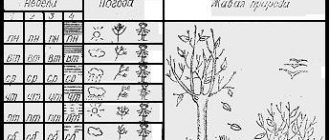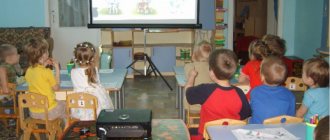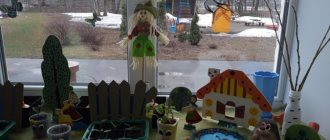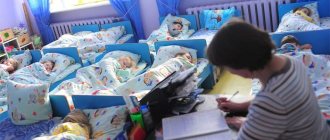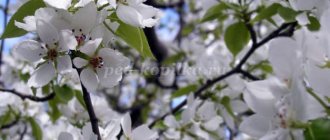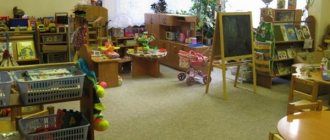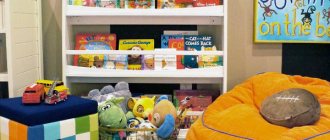Design of the “Nature Calendar” corner for all age groups
Alsou Salakhova
Design of the “Nature Calendar” corner for all age groups
Presentation on the correct design of the “ Nature Calendar ”
for
all age groups
To capture changing natural objects, various types of graphic models can be developed. In the pedagogical interpretation, these are calendars of observations of natural . Their main content is acquaintance with birds and other changing seasonal phenomena of nature , the growth and development of living beings. Keeping a calendar gives children the opportunity to get acquainted with wintering birds and track the dynamics of changes in autumn-spring bird migrations. As the practice of preschool education shows, understanding the patterns of seasonal changes is associated with a number of difficulties. This applies primarily not to the assimilation of the characteristic features of the seasons, but to the understanding of the process of gradual growth of these features and qualitative changes during the transition from one season to another. The absence of a sharp visible boundary between the seasons gives children a misleading idea of the constancy of the environment. At the end of autumn, for example, children forget that at the beginning it was warm, there were a lot of flowers and greenery. Children without the help of an adult do not grasp the logic of natural changes.
I will present you with calendars for the junior , middle, senior and preparatory groups .
For the second junior and middle groups , this is a set of pictures for each season, which depict the main weather phenomena in accordance with the program. Kids need to learn to highlight the sun, clouds, rain, etc. The same tree should be drawn in a number of pictures (for example, a birch)
in different conditions: in calm and windy weather, in rainy and sunny weather, with green leaves, with yellow leaves during leaf fall, without leaves.
There should also be a flat cardboard doll with a set of paper clothes for all seasons. With the help of pictures, children consolidate ideas about natural obtained during observations.
The doll helps determine the degree of heat or cold and introduces a playful element into the children’s activities. The methodology of working with children corresponds to age characteristics . With kids, the teacher observes each phenomenon separately (for example, only rainy weather or only leaf fall)
.
With children of the middle group , it is already possible to simultaneously observe two or three phenomena (windy and rainy weather or the coloring of leaves on bushes and trees and their falling off when there is a gust of wind).
When getting ready for a walk on Monday, the teacher shows the children a doll, tells her name, says that she came to visit the children and wants to see how they dress. After the walk, the doll waits for the kids to undress - she can’t wait to find out what they saw on the site. The teacher invites the children to name what they noticed during observations (sun, rain, etc.)
.
“Now we will show you a picture
,” says the teacher, turning to the doll, and takes out a box with a set of cards depicting various
natural . He shows a card that doesn’t show what the guys saw on their walk. “Children, you and I looked at the sun. Is this the sun? “No, these are clouds, let’s find another picture where the sun is drawn.” Children find the desired picture, show it to the doll and place it on a stand (like a book stand)
.
“You probably want to go for a walk too? - the teacher addresses the doll. - Take a walk here (puts it near the card)
.
The sun will shine on you. You just need to get dressed. It’s warm today, the guys wore light blouses during the walk. You put on a blouse too.” The teacher finds a paper blouse, puts it on the doll and says that Natasha (the doll’s name)
is now also walking.
Daily observations using cards and dolls during the first week will help children of the second younger group begin to become familiar with the variety of natural phenomena . In rainy weather, when the children do not go for a walk, the teacher makes observations from the window. The children are interested: everything around is wet, shiny, raindrops are crawling on the glass. The teacher draws attention to the fact that the children do not walk on the street, only adults go about their business - they are wearing raincoats, some have umbrellas. The doll appears in such weather. The children find a card depicting rain and let Natasha go for a walk, putting a raincoat on her or urgently making an umbrella.
In the middle group the same principle of working with the calendar , but four-year-old children are already observing the weather more thoroughly, noting its characteristic signs (for example, the wind appears and then subsides; a cloud rolls in, it rains, then the sun shines again). In this case, two or three pictures are displayed (birch in a calm state, birch in a gust of wind - leaf fall, etc.). The doll may be the same, but she should have a new set of clothes (she grew up - they bought her new clothes)
.
Thus, working with a set of pictures and a doll in the second junior and middle groups helps children develop clear ideas about seasonal natural and teaches them to record observations with the power of ready-made image-pictures. Through play, preschoolers are taught the ability to determine the degree of heat and cold. All this is the basis for maintaining a nature calendar in older preschool age .
The nature calendar for senior , preparatory to school groups consists of three columns: 1) time; 2) inanimate nature (weather)
;
3) living nature (flora and fauna, human labor. In the calendar of children of the sixth year of life, the first column is represented by one week, in the calendar of children of the seventh year of life - four (the cells of the second week are filled in, the rest are empty)
. This is important for the formation in children, going to school, distinct temporary ideas: when discussing the completed
calendar, he sees that there are four weeks in September, and observations of seasonal natural were carried out during one (second)
week. Later, when filling out
the calendar , they will understand the temporal length of the season: three months , each of which consists of four weeks, each of which in turn consists of seven days.
Every day after the walk, the children paint the cell corresponding to the given day and put down icons indicating the weather. At the end of the week (on Thursday or Friday, after observing the vegetation and the animal world, preschoolers draw a picture of wildlife .
When maintaining a calendar, you need to pay attention to the following points: it must be filled out by children in a timely manner under the guidance of the teacher; conventional icons are schematized drawings of phenomena that children observe. Special stencils made by the teacher from thick transparent film or cardboard will help you calendar cells neatly and beautifully This is especially important in the early stages in the older group , when children are just getting acquainted with this type of calendar . Drawing with stencils is interesting for preschoolers and neutralizes the difference in their visual skills.
To develop the ability to fill out a calendar , i.e., record the results of your observations, as well as the ability to read them (talk about observations on the calendar ), it is important that the symbols are simple and understandable to children. The following symbols are most suitable: days of the week - in different colors, weather - with naturalistic icons (for example, wind - a tree leaning to the side, snow - a graphic image of snowflakes, etc.) Particular attention should be paid to the graphic image of the degree of heat and cold: this is a schematic figure of a child, dressed differently, in shorts , dress, in a coat (jacket, fur coat. Preschoolers understand such icons, since they correspond to their clothes during a walk. If it is difficult for children to depict birds so that they differ by species, the drawing can be replaced with a “tick”
of one color or another, for example, a sparrow is a brown
tick
, a dove is blue, a tit is yellow, a bullfinch is red, etc.
The experience of introducing calendars into the practice of kindergartens has shown: the use of this type of modeling has an intense impact on the development of visual-figurative thinking. Working with the calendar at all stages (filling out, summing up, repeated examinations, comparing similar phenomena) enriches children’s specific ideas, forms a special type of ideas that reflects the process of changing natural in unity with the time parameter. However, the formation of this type of representation is possible only with regular, time-ordered recording of observations. The model thus serves as a means of developing unified spatiotemporal concepts. In addition, when discussing the results of observations, children are forced to compare the phenomena recorded on the pages of the calendar , trace the nature of changes, the relationship of individual components; Thus, they learn to detect temporary and causal relationships and establish the simplest patterns. Thus, logical thinking develops, and with it, speech inextricably develops. What is meant here is a special, so-called collective form of speech - a conversation between a teacher and a group , when statements are mutually complemented, when the content of the conversation, unified in meaning and complete in form, is created. It should be noted that the calendar is the subject of a logically structured discussion, which contributes to the development of skills to reason, analyze, compare events, and then reflects them in speech (conclusions, generalizations, i.e. serves as a visual means of teaching logical operations.
Types of calendars
Calendars vary in location.
They are:
- Tabletop
- Wall mounted
- Kitchen
Desk calendars are either triangular or placed on a stand. They are most often placed on a desk. Although small calendars can be placed on a bookshelf.
The name of the wall calendars speaks for itself. They hang on the wall. Such calendars can be either multi-page or single-page.
Kitchen calendars are a type of single wall calendar. The difference is that kitchen calendars are attached to the refrigerator using magnetic tape.
By type, calendars are divided into:
- Reversible (on rings or springs)
- Tear-off
- Advent calendars
- Perpetual calendars
Why do you need to keep a weather diary?
Keeping a weather diary in primary and secondary school is not new. Parents of modern children at one time also scrupulously recorded observations of weather changes. At the same time, the majority, having taken up the task with enthusiasm, quickly burned out and entered data at random. In order to keep a diary every day for 9 months, serious motivation is required.
5 reasons to keep a weather calendar:
- Daily observations of weather changes teach mindfulness.
- Keeping a weather diary helps consolidate knowledge about nature.
- Systematic journal entries help you become disciplined and responsible.
- You can notice certain patterns, which will help you better navigate the features of the environment (predict bad weather, etc.).
- You can compare the calendar data with folk signs, and thus verify their veracity.
Observing weather changes over a long period of time has led to the emergence of many signs about the weather:
- “October 4 - Kondraty and Ignat. The weather of this day should remain unchanged for four weeks.”
- “If the leaves fall quickly in the fall, expect a cool winter.”
Signs reflect patterns of changes in nature. They were used to make weather forecasts, which were especially important for farmers, sailors, travelers and cattle breeders.
Note. In the future, students will need to analyze the data in the diary. Schools give different assignments in different grades. For example, indicate the lowest and highest air temperatures in autumn, display the average temperature in September, and count the number of cloudy and clear days in each month. In 6th grade, children will need to plot a temperature graph and construct a wind rose.
Example tables and legend
Each school and each class uses its own weather diary templates. Children who learn from printed notebooks often enter data into a special insert with a table. This is what the nature calendar looks like for 2nd grade students:
Here are the symbols of natural phenomena and weather elements that need to be noted:
Note. A elementary school student needs a weather diary for the subject “The world around us.” In grades 5 and 6, students fill it out for the Geography subject.
In elementary school, children only note cloudiness, air temperature, wind strength (determined by trees), precipitation and other weather phenomena. In high school you will need to measure atmospheric pressure and determine wind direction.
Examples of weather diaries for schoolchildren:
- 3rd class:
- 4th grade:
- 5th grade:
- 6th grade:
Usually the teacher himself will tell you which form to use for keeping a weather diary and where to get it. Printouts may be provided to students. Example of a form for October:
Old-school teachers are often asked to draw a table in their notebooks themselves. Sometimes a column is added for comments about the weather. Examples of such a diary:
Common designations:
- arrow up - north wind;
- down arrow – south;
- to the right – eastern;
- left – western;
- arrow with three stripes – very strong wind;
- two stripes – medium;
- one band – weak;
- open circle – clear day;
- half filled circle – partly cloudy;
- dark circle – the sky is overcast;
- snowflake - snow;
- drop - rain;
- lightning - thunderstorm.
Sometimes schoolchildren are even allowed to keep an observation diary on the computer in a table created in Word. You must select the “Insert” tab and click “Create Table”. In the “Shapes” subsection you can find all the main symbols: arrows, sun, clouds, etc.
Perpetual calendar
Such a calendar provides for a constant change of numbers and inscriptions indicating the week, month and year.
- Based on this, the calendar should be made “movable,” that is, with the ability to shift or rotate elements.
- You can make special windows or pockets on the general canvas in which the data will change.
- Or they can be written on separate pieces of paper and attached with decorative clothespins to the canvas (board).
- Such calendars can be made of cardboard, wood or fabric.
Perpetual calendars in the form of cubes with numbers and inscriptions printed on them are very convenient.
Whatever calendar you make with your own hands, it will always play the role of not just a calendar, but a wonderful decorative element that adorns your home.
How to do this correctly?
You need to keep a diary of weather observations according to certain rules:
- Make notes at the same time. Typically, primary school students fill out a weather diary at noon, and in secondary schools, data is recorded three times a day: before classes, after classes and late in the evening.
- Measure the air temperature using a thermometer. You need to make sure that the device is in the shade, otherwise the readings will be greatly inflated.
- Determine the wind direction using a weather vane.
- Atmospheric pressure is measured using a barometer.
- Make observations daily.
- Enter all precipitation for the day and note any weather phenomena that were observed.
- Make notes carefully: draw symbols with a pencil, and write numbers with a pen.
Advice. To make your diary look more colorful, you can draw all the weather changes that happened during the month with a colored pencil.
Wall calendar
Wall calendars are usually made in large format. The numbers and inscriptions on it are larger.
- For the base you will need cardboard onto which decorative paper is glued. And on top of it a calendar grid and decor are attached.
- For decorating such calendars, for example, family photographs, children's drawings or pictures characterizing the seasons are well suited.
- If the calendar is made for a children's room, then you can place images of the child's favorite cartoon characters on it.
- A wall calendar can be made without fastenings and simply glued to the wall. Or make fasteners (for example, from wire) to hang it on a hook or nail.
When making a one-page calendar from felt or thick fabric, you can make a 3-4 cm fold at the top, stitch it, and insert a stick into this fold.
Attach a rope or cord to its edges. And hang the calendar on a nail using this rope.
